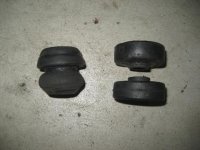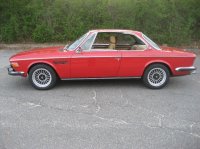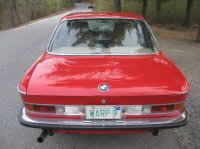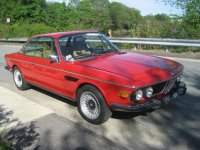thehackmechanic
Well-Known Member
As many of you know, I've had the '73 3.0CSi since 1986. It's always had a vexing clunking sound in the rear. Last night, I finally figured it out.
The outer body restoration was done on this car around 1988. It took more than all the money I had in the world, so other work was done in phases. At some point around 1990 I pulled out what were probably the original shocks and struts and installed Bilstein HDs all around. This was 20 years ago so details are a little hazy, but I remember that I thought that the stiffer shocks were exacerbating the car's rattles (many of the rattles were coming from the fact that the car was not very carefully reassembled after it was painted, but I hadn't figured that out yet). I remember that, in particular, there was this clunk in the back that I couldn't get rid of, that seemed to be coming from the right rear shock. I did something incredibly stupid (hey, I was still in my 20s) -- I put the impact wrench on the nut on the shock's threaded stud to really snocker the thing down.
I snapped the stud off the top of the right Bilstein shock.
When this happened, I actually wrote about it in Roundel. Hey, if you're going to do something incredibly stupid, you might as well let it all hang out.
If memory serves me right, my snapping the top off the Bilstein, combined with thinking that the Bilsteins were too stiff anyway, made me replace both the front and rear shocks and struts. I bought KYBs for the rear (yes I now know that people report that these are stiffer than HDs but I didn't know that then), and Boges for the front.
The Boges were a disaster; the front of the car was so wallowy that the car literally made me nauseous. I put the front HDs back in. But the KYBs stayed in the back. So did the clunk. Tightening the nuts down seemed to lessen it, but after the episode with snapping the top off the Bilstein, I didn't want to overdo it.
As I wrote about a few weeks ago, I scored a set of staggered 16" Alpinas, and that turned into the trigger to spend some time with the 3.0, which has seen very few miles since I put it on a Hagerty policy six or seven years ago. I stumbled upon the rear Bilsteins, including the one with the snapped-off stud at the top, in my garage. These are the older inverted style with the bellows at the bottom. I took the broken one around to a few welding and machine shops to see if there was any reasonable way of replacing or extending the snapped stud, but no one would touch it.
Then I happened into a set of inverted HDs (B46-0813-H001) on Craigslist for eighty bucks. I bought them and began to install them yesterday. I immediately noticed that they had a different bushing on the top, the style that's a single rubber piece (left in attached photo) that has to be pressed through the hole in the top of the shock tower, whereas the shocks that I'd had in my car -- both the HDs and KYBs -- used the two-piece bushing (right in attached photo) where you slide one on the stud, put the stud up through the hole, then slide the other one on the stud, and the ridges in the bushings nestles in the hole at the top of the shock tower. I installed the new old HDs using the two-piece bushings.
I drove it and immediately noticed that the clunk was worse. I was about to tighten down on the nuts when I thought that, perhaps, I should take a more careful look at things.
What I found was this. It turns out that the tops of both of my shock towers have been repaired. I didn't know this before, but I now assume that the original shock towers accept the single pressed-in rubber bushing. This means that they have a big hole, close to an inch across. On my left shock tower, a plate has been welded in on top of the original, and the hole is much smaller, about 9/16, meant to accept the split style of bushing. The center ridge of the bushing is meant to inset into the hole. Looking up from underneath, I can still see the original larger hole.
But on the right, incredibly, the hole was only large enough for the stud itself, not for the ridge in the bushing. In other words, the banging I've been hearing for 20 years has been the stud at the top of the shock hitting the inside of the hole because there wasn't any rubber bushing between it and the body of the car.
I just took a 9/16" bit and enlarged the shock tower hole so the bushing will sit inset into the hole, and reinstalled the shock. Right now there's a thunderstorm passing through Boston, but I can't imagine that this won't solve the problem.
--Rob
The outer body restoration was done on this car around 1988. It took more than all the money I had in the world, so other work was done in phases. At some point around 1990 I pulled out what were probably the original shocks and struts and installed Bilstein HDs all around. This was 20 years ago so details are a little hazy, but I remember that I thought that the stiffer shocks were exacerbating the car's rattles (many of the rattles were coming from the fact that the car was not very carefully reassembled after it was painted, but I hadn't figured that out yet). I remember that, in particular, there was this clunk in the back that I couldn't get rid of, that seemed to be coming from the right rear shock. I did something incredibly stupid (hey, I was still in my 20s) -- I put the impact wrench on the nut on the shock's threaded stud to really snocker the thing down.
I snapped the stud off the top of the right Bilstein shock.
When this happened, I actually wrote about it in Roundel. Hey, if you're going to do something incredibly stupid, you might as well let it all hang out.
If memory serves me right, my snapping the top off the Bilstein, combined with thinking that the Bilsteins were too stiff anyway, made me replace both the front and rear shocks and struts. I bought KYBs for the rear (yes I now know that people report that these are stiffer than HDs but I didn't know that then), and Boges for the front.
The Boges were a disaster; the front of the car was so wallowy that the car literally made me nauseous. I put the front HDs back in. But the KYBs stayed in the back. So did the clunk. Tightening the nuts down seemed to lessen it, but after the episode with snapping the top off the Bilstein, I didn't want to overdo it.
As I wrote about a few weeks ago, I scored a set of staggered 16" Alpinas, and that turned into the trigger to spend some time with the 3.0, which has seen very few miles since I put it on a Hagerty policy six or seven years ago. I stumbled upon the rear Bilsteins, including the one with the snapped-off stud at the top, in my garage. These are the older inverted style with the bellows at the bottom. I took the broken one around to a few welding and machine shops to see if there was any reasonable way of replacing or extending the snapped stud, but no one would touch it.
Then I happened into a set of inverted HDs (B46-0813-H001) on Craigslist for eighty bucks. I bought them and began to install them yesterday. I immediately noticed that they had a different bushing on the top, the style that's a single rubber piece (left in attached photo) that has to be pressed through the hole in the top of the shock tower, whereas the shocks that I'd had in my car -- both the HDs and KYBs -- used the two-piece bushing (right in attached photo) where you slide one on the stud, put the stud up through the hole, then slide the other one on the stud, and the ridges in the bushings nestles in the hole at the top of the shock tower. I installed the new old HDs using the two-piece bushings.
I drove it and immediately noticed that the clunk was worse. I was about to tighten down on the nuts when I thought that, perhaps, I should take a more careful look at things.
What I found was this. It turns out that the tops of both of my shock towers have been repaired. I didn't know this before, but I now assume that the original shock towers accept the single pressed-in rubber bushing. This means that they have a big hole, close to an inch across. On my left shock tower, a plate has been welded in on top of the original, and the hole is much smaller, about 9/16, meant to accept the split style of bushing. The center ridge of the bushing is meant to inset into the hole. Looking up from underneath, I can still see the original larger hole.
But on the right, incredibly, the hole was only large enough for the stud itself, not for the ridge in the bushing. In other words, the banging I've been hearing for 20 years has been the stud at the top of the shock hitting the inside of the hole because there wasn't any rubber bushing between it and the body of the car.
I just took a 9/16" bit and enlarged the shock tower hole so the bushing will sit inset into the hole, and reinstalled the shock. Right now there's a thunderstorm passing through Boston, but I can't imagine that this won't solve the problem.
--Rob





